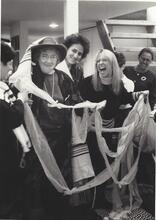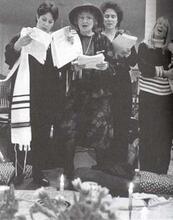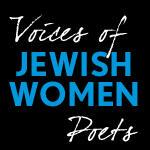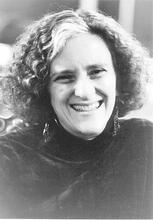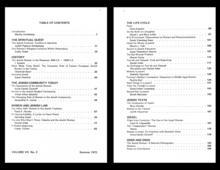Feminine Images of God
Jewish scripture includes few examples of a feminine or woman-personified God. The Hebrew Bible contains limited explicit reference to a female personification of God; more frequently God is described as a father or man in general, and with stereotypically masculine characteristics. Foundational Kabbalistic texts have been taken to be implicit representations of femininity, as one of the manifestations of God’s presence in the world has been characterized as female. Both medieval and contemporary theology have largely rejected the idea of divine gender, although there are some dissenters to this argument. Modern feminist theologians in particular have interpreted texts to draw comparisons to the feminine experience.
The myriad ways in which God and divinity have been thought, uttered, imagined, depicted and expressed in Jewish tradition resist easy characterization. Judaism’s radical monotheism is a standing challenge to human sensibilities, which rely so heavily on metaphors and sensual representations to make sense of ourselves and of our world. Ideas of “masculine” and “feminine” are of course stereotypical, though like many stereotypes they can at times convey some rough social truths and correspond to some historical realities. In the case of Jewish thought, grammar at times meets theology inasmuch as impersonal Hebrew nouns are gendered, so that words like hokhmah (wisdom) and shekhinah (presence) over time lent themselves by virtue of their feminine (-ah) endings and in context with theological and other developments to more explicitly gendered meanings.
Hebrew Bible and Talmud
The Hebrew Bible rejects the Near Eastern pantheon of gods and their female consorts in favor of one God, creator of all humanity, male and female alike, who enters into an intense covenantal relationship with the Children of Israel; this relationship is regularly depicted as a marriage, with God as husband and Israel as wife (most vividly in Hosea). The male and female attributes ascribed by Near Eastern religions to gods and goddesses are incorporated as one into the Biblical God. Thus while the God of the Old Testament is, famously, a king and ruler and “a man of war” (Ex. 15:3), He “loves the stranger whom He provides with food and clothing” (Deut. 10:18). More to the point, the intercessions of Abraham, Moses, and Samuel, invoking God’s mercies against His judgment, and the oracles of the classical prophets themselves, point to a tension within God between exacting justice and forgiving mercy.
God is sometimes, though rarely, described in explicitly maternal terms, as in Is. 46:3–4. In the Book of Proverbs, Wisdom, God’s first creation and the guiding spirit of the world, is personified as woman, and indeed the “woman of valor” celebrated in Chapter 31 is Wisdom’s living embodiment, though the book is also replete with less edifying images of the femme fatale.
In the Lit. "teaching," "study," or "learning." A compilation of the commentary and discussions of the amora'im on the Mishnah. When not specified, "Talmud" refers to the Babylonian Talmud.Talmud, God is regularly featured as father, and Talmudic literature is replete with parables, dialogues, and metaphors casting God as a father, both as Father/King/Teacher, and as a more supernal Father in Heaven with whom relations are less direct, who is approached with awe through religious action. At the same time, a more intimate and less forbidding range of divine-human interactions is also to be found; the erotically charged Song of Songs is read by the Rabbis as an allegory of the loving relationship between God and Israel.
Moreover, the Rabbis regularly discuss God in terms of two clusters of attributes, middat ha-din and middat ha-rahamim, those of law and mercy, joined in a divine will transcending both. The Talmud also introduces the term Shekhinah to connote God’s presence in the world. Though the term is grammatically feminine, in the Talmud it is not explicitly gendered, though in some passages it refers to moments when God shares in human experiences of loneliness, loss, and exile. The Wisdom of Proverbs is, in the Talmud and A type of non-halakhic literary activitiy of the Rabbis for interpreting non-legal material according to special principles of interpretation (hermeneutical rules).Midrashim, almost wholly identified with Torah she-bi-khetav: Lit. "the written Torah." The Bible; the Pentateuch; Tanakh (the Pentateuch, Prophets and Hagiographia)Torah.
Medieval Interpretations
For the medieval philosophical tradition, the ascription of any gender to God was considered both logically impossible and theologically unacceptable. For the philosophers, the Shekhinah was God’s glorious presence and, in a departure from Talmudic usage, a distinct, albeit sublime, creation, yet devoid of any gender. The philosophers avoided feminine personifications of Hokhmah, which they variously understood as referring to the Aristotelian Active Intellect (Levi ben Gershom [Gersonides], 1288–1344); Torah (David Kimhi [Radak], 1160? –1235?); moral instruction (Menahem ben Solomon ha-Meiri, 1249–1316), or practical knowledge (Isaac ben Moses Arama, c. 1420–1494).
However, a reconceptualized and internalized Wisdom did receive expression in medieval poetry and The esoteric and mystical teachings of JudaismKabbalah, in several ways. It was sometimes thought of as the soul, conceived of as female to God’s male, yet derived from God himself, and longing for reunion. Thus, the eleventh-century poet and philosopher Solomon ben Judah ibn Gabirol (c. 1020–c. 1057) in his monumental poem Keter Malkhut: “As You created from your majestic splendor a pure light … and called her the Soul … and if she achieves purity, she will laugh on the last day. …” In the mystical teachings of the Kabbalah the sought-after reunion of the soul with God came to be seen as a refraction of a larger drama of reunion between male and female principles within the divine itself.
Kabbalistic Interpretations
In Sefer ha-Bahir, the foundational Kabbalistic text of twelfth-century Franco-Germany, we find, within the already developed doctrine of the ten sefirot, the clusters of divine attributes and symbols that provide the underlying structure of God’s manifestation in the world, that the tenth sefirah is identified with Shekhinah, with Solomon’s Wisdom and with Lit. "assembly." The 120-member parliament of the State of Israel.Knesset Israel, the sacred community of Israel. It serves within this framework as the largely passive point of contact between the transcendent divinity and the cosmos we know.
In the Spanish Kabbalah of the thirteenth century, and above all in the magnum opus, the Zohar, the intra-divine drama is powerfully depicted, as indeed the Song of Songs is now re-read as an allegory of love and longing within a divine realm of extraordinary complexity.
The Shekhinah as passive expression of femininity at the bottom of the structure of the sefirot is now complemented by the feminized depiction of the third sefirah, that of binah (insight), referred to as “the higher Shekhinah” and “the mother of the Sefirot,” a locus of creative and healing power. The “higher Shekhinah” of binah receives divine energies from the second sefirah, hokhmah (now seen as male) and diffuses them throughout the intra-divine realm. The “lower Shekhinah,” also known as malkhut, the world of power, flows out into the created world and at times is identified with the Oral Law.
At times, though, the Zohar identifies the lower Shekhinah with evil and the demonic, precisely because it represents the point at which divine energies threaten to separate from their higher sources. Moreover, and contrary to some of our modern assumptions, the “right” side of the sefirotic structure, that which gives unstintingly and in kindness, is consistently characterized as masculine, and the left side, of judgment, passivity and limitation is correspondingly characterized as female.
In post-Zoharic Kabbalah great emphasis was placed on the crucial role of human action, of A biblical or rabbinic commandment; also, a good deed.mitzvot and good deeds, in energizing the Shekhinah and reuniting it with the other sefirot. In the widely influential Lurianic Kabbalah of the sixteenth century, the Shekhinah was somewhat depersonalized and—joined to the Talmudic understanding of Shekhinah as a more empathic and engaged dimension of divinity— was powerfully reconceived as the facet of God that is lost in the world, present in exile and longing for reunion and redemption. This in turn found expression in some of the Tkhines, Yiddish devotional prayers written for, and sometimes by, women in the early modern period; it later came to serve as the basis, in the eighteenth and nineteenth centuries, for Hasidism’s conception of seeking out and restoring the “sparks of divinity” scattered throughout creation.
Modern Interpretations
In modern times, Jewish theology in the West has generally taken as its frames of reference the rationalist tradition as well as post-Kantian philosophy, in both of which the notion of divine gender is incoherent if not blasphemous. At the same time other thinkers, some staunchly traditionalist, do provide ways of thinking about God in terms that resonate with some currents in feminist theology. Thus, Martin Buber’s dialogic theology of I-Thou, Abraham Joshua Heschel’s explorations of divine pathos, the The legal corpus of Jewish laws and observances as prescribed in the Torah and interpreted by rabbinic authorities, beginning with those of the Mishnah and Talmud.halakhic existentialism of Joseph Soloveitchik and the explorations by Abraham Isaac Kook of the subjective inner life as reflecting the intra-divine drama as lived out in historical time, each in their way offer modes of thinking beyond obviously paternal and patriarchal images of God.
Contemporary feminist theologians such as Rachel Adler and Tamar Ross and liturgists as different from each other as Marcia Falk and Zelda work with the texts and ideas discussed here, as well as with new understandings of Biblical concepts such as berit, covenant, matan Torah, and revelation, towards richer and more inclusive understandings of God’s presence in Jewish history and Jewish life, in which feminine experience will find an echo and serve as its own reference point for ethics and spirituality. Perhaps in the end it is precisely the radical monotheism demanded by Judaism that points a way towards recognizing the divine origin of both “male” and “female” en route to transcending both.
Adler, Rachel. Engendering Judaism. Philadelphia: 1998.
Claassens, Juliana M. Mourner, Mother, Midwife: Reimagining God’s Delivering Presence in the Old Testament. Louisville, KY: Westminster John Knox, 2012.
Dille, Sarah J. “Mixing Metaphors: God as Mother and Father in Deutero-Isaiah.” In Journal for the Study of the Old Testament, Supplement Series 398, Gender, Culture, Theory 13. London: T & T Clark International, 2004.
Falk, Marcia. The Book of Blessings. Boston: 1996.
Fischer, Irmtraud. “Isaiah: The Book of Female Metaphors.” in Feminist Biblical Interpretation, edited Luise Schottroff and Marie-Theres Wacker. Grand Rapids, MI, Cambridge, UK: Eerdmans 2012, 303-318.
Frymer-Kensky, Tikva. In the Wake of the Goddesses: Women, Culture and the Biblical Transformation of Pagan Myth. New York: 1992.
Graybill, Riannon. “Yahweh as Maternal Vampire in Second Isaiah.” Journal of Feminist Studies in Religion 33, no. 1 (2017): 9-25.
Green, Arthur. “Shekhina, the Virgin Mary and the Song of Songs.” AJS Review 26, no. 1 (2002): 1–52.
Gruber, Mayer I. “The Motherhood of God in Second Isaiah.” In The Motherhood of God and Other Studies. Atlanta: Scholars Press 1992, 3-15.
Idel, Moshe. “Sexual Metaphors and Praxis in the Kabbalah.” In The Jewish Family: Metaphor and Memory, edited by David C. Kraemer, 179–224. New York: 1989.
Mirsky, Yehudah. “A Shtiebel of One’s Own.” Sh’ma. January 20, 1995.
Muffs, Yohanan. Love and Joy: Law, Language and Religion in Ancient Israel. Cambridge: 1992.
Ross, Tamar. Expanding the Place of Torah. Orthodoxy and Feminism. Hanover: 2004.
Schafer, Peter. Mirror of His Beauty: Feminine Images of God from the Bible to the Early Kabbalah. Princeton: 2002.
Scholem, Gershom. On the Mystical Shape of the Godhead: Basic Concepts in the Kabbalah [translated by J. Neugroschel and J. Chipman]. New York: 1991.
Schwartzmann, Julia. “Gender Concepts of Medieval Jewish Thinkers and the Book of Proverbs.” Jewish Studies Quarterly 7, no. 3 (2000): 183–202.
Weissler, Chava. Voices of the Matriarchs: Listening to the Prayers of Early Modern Jewish Women. Boston: 1998.
Wolfson, Elliot R. “Female Imaging of the Torah.” In Circle in the Square: Studies in the Use of Gender in Kabbalistic Symbolism, 1–28. Albany: 1995.
Wolosky, Shira. “The Lonely Woman of Faith.” Judaism 52, no. 1–2 (2003): 3–18.

